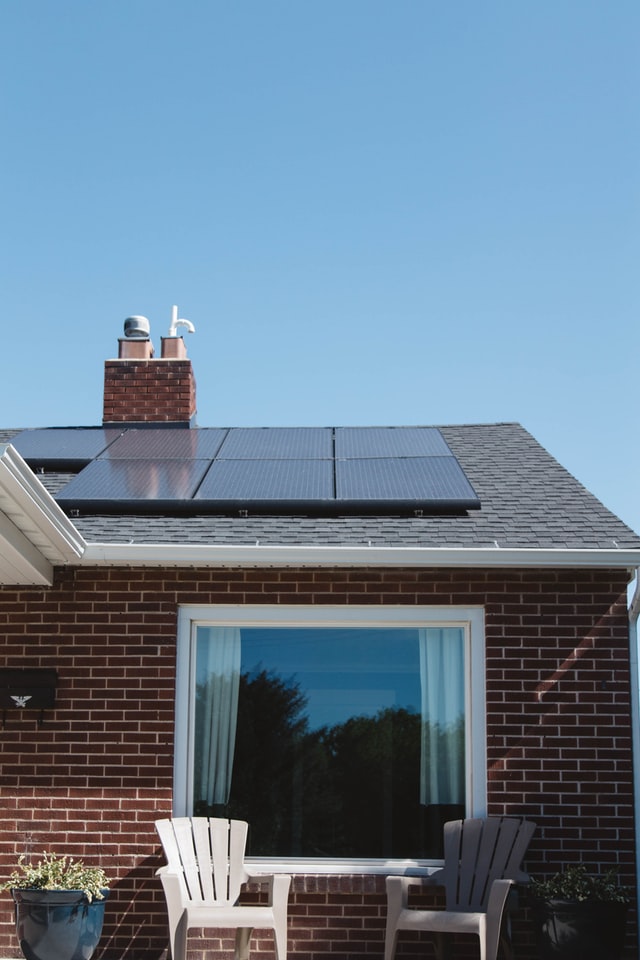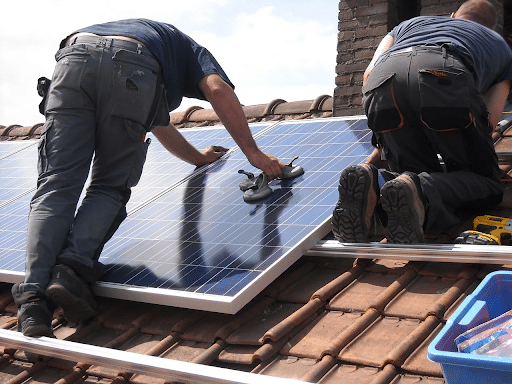Table of Contents
ToggleSolar panels use photovoltaic (PV) power generation, which is a solid-state semiconductor device that absorbs sunlight. The PV panels then convert the collection of sunlight into electricity. Hence, the location and placement of your solar panel plays a vital role in order to receive the best energy output.
There are various reasons why more people are choosing solar power, the main reason being exponentially bigger savings in the long run. It will also help reduce carbon footprint as solar energy is infinite and comes from a natural, renewable source, unlike fossil fuels.
Where is the best place to install solar panels?
There are basically two types of solar panels, one that is installed on the roof top and another which is ground-mounted.
- Solar roof panels
- 2.Ground-mounted solar panels
Solar panels are usually installed on the roof, but it can also be mounted on the ground, provided the area is large enough and has excellent sun exposure.
There are two main key factors to determine before installing solar panels which are :
- Finding an area with the best sunlight exposure.
- The direction and position of your solar panels.
Solar roof panels
Solar roof panels help to convert natural energy from the sun into a usable power source for your home by generating electricity. Many choose this option as the rooftop will provide consistent and the most uninterrupted sunlight throughout the day.
Ground-mounted solar panels
A ground-mounted solar panel uses a system of solar panels that are mounted on the ground of your property; the height range of this structure varies from just a few inches to several feet above the ground. A wide ample space of land is required and this space must also have a direct source of sunlight to receive optimal sun exposure. The chosen area must be free from obstructions of buildings, trees and away from sun shading.


Factors to consider when installing solar panels
As solar power technology is highly sought and growing rapidly in recent years, numerous advancement efforts have been made making it affordable and possible for home use.
Here are a few factors to consider in order to maximise the technology of solar panels:
Solar panel orientation and inclination
The orientation and inclination of solar panels plays an important role in maximizing the amount of sunlight captured.
It is important to calculate and to evaluate all the angles in order to achieve maximum optimization of photovoltaic cells.
Get a certified solar installer to calculate the precise direction for you, as magnetic declination will give you the most accurate calculations.
It is highly recommended for solar panels to face true south.This is because the sun is always along the southern part of the sky and our location is in the northern hemisphere.
Available space
The general rule of thumb to bear in mind is that every square root of space generates approximately 15 watts of solar energy.
Therefore, depending on the size of your house, ample space is required in order to generate sufficient solar energy to power your home. A ground mounted solar panel will require a huge vacant space of land whereas a roof solar panel will only occupy space on your roof.
Near shadings & Location of your home
The area in which your home is located is important when considering solar panels. If you live in a built up area surrounded by buildings or a skyscraper, it will be difficult to collect sufficient sunlight.
Any potential obstacles will reduce the efficiency significantly. It is important to consider shading from buildings, trees and even passing clouds.
The output performance will also be compromised even when the shadow falls on only one part of the solar panel.
Proper permits
Make sure to receive the necessary approval from your municipal authority and gather all relevant information before starting the project. Different districts usually have a different set of rules, requirements and regulations.
Future plans
Solar panels are a hefty investment and it will take a span of approximately 5 to 7 years for it to be worth the money spent. Invest only if you have no future plans of moving or relocating.


Energy output
Consult a solar installer to ensure that the solar panels installed are able to generate sufficient energy to help provide enough electricity for your home. You will need to discuss with your solar technician on the required output needed to power your home.
Quality, durability and lifespan of the solar system
Look for a provider that is certified and licensed, they will provide better after-sales service with longer warranty coverage. As this is a long term investment it is important to do some research before choosing to commit yourself.
Cost
Rooftop solar panels cost significantly less as there is already a pre existing infrastructure, and the panels must just be mounted on the roof. Whereas, a structure needs to be built, requiring much more work, with proper permits, plans, thus making ground mounted panels much more expensive.
Are certain types of solar panels more effective?
You will come across the term solar panel efficiency often when researching solar panels. Efficiency is measured by determining the percentage of solar power that successfully converts usable energy into electricity.
There are 3 main types of solar panels, which are monocrystalline panels, polycrystalline silicon panels and thin film solar cells. Monocrystalline panels are the most efficient type with the highest power capacity.
Monocrystalline silicon panels / Single crystal panel
Monocrystalline silicon panels are the most expensive and efficient photovoltaic solar panels available. They are made from pure silicon, making it more durable and long lasting. It is also most space-efficient as fewer panels are needed compared to the other types. Monocrystalline panels have the capability of reaching approximately 20% efficiency due to their pure and superior silicon structure.
Polycrystalline silicon panels / Multicrystalline Panel
Polycrystalline silicon panels contain lower amounts of silicon and are made by fragments of silicon crystals melted together. This is a cheaper alternative making this the common choice for homeowners. Polycrystalline panels have an efficiency rating of approximately 15% to 17% efficiency due to having less silicon.
Thin Film Solar Cells
Thin film solar cells are a relatively new photovoltaic technology and currently the cheapest option. Thin Film Solar Cells are made from a variety of photovoltaic substances that produce a flexible and thin lightweight sheet.
Careful handling is required when assembling as they are fragile and thinner in nature compared to the other two solar panels. Thin film solar cells are the least efficient choice, and usually reach approximately 7% efficiency. Therefore, in order to generate enough energy, you would need to install more thin film solar cells which requires a larger space.
Must solar panels be attached to the roof?
Solar panels are most commonly installed on the roof due to space constraints, making it the predominant choice. However, they can also be installed in any other location that has a wide area with a direct source of sunlight.
A wide yard free from obstruction, a garage, and barns are common alternatives areas where solar panels can be installed.


Rooftop solar system vs ground PV system
The main factor when deciding between a rooftop solar system vs ground PV system is appearance. Most people would prefer having a system that is out of sight without causing any obstructions.
Here are some pros and cons between the two :
Rooftop solar system
Panels are installed onto the rooftops for a rooftop solar system. As every roof is different the angle of panels is limited depending on the roof slope.
Pros
- An excellent alternative for homes without any extra land.
- Utilize a non active space of your home, as the roof is usually an area left vacant.
- A cheaper alternative as the equipment required for mounting is minimal making the installation faster and easier.
Cons
- Harder to clean by yourself and usually requires professional help to maintain the rooftop solar system.
- A damaged roof must be replaced to avoid future problems like leaking.
- Rooftops that face the wrong direction and small roofs with inadequate surface area will not be able to generate optimal solar energy.
Ground PV system
A ground PV system is a system of solar panels installed slightly elevated and mounted on the ground. There are three types of racking systems which are a single-axis tracker, dual-axis tracker and a fixed-tilt.
Pros
- A ground PV system is easier aligned to achieve the best angle.
- Easier to clean and maintain, as it is close to the ground.
Cons
- This option requires a large space of land.
- More expensive as ground mounts require extra framework, cement foundations and reinforced pole structures.
- Takes up a significant amount of space on your land.
Can I install solar panels myself?
- Harder to clean by yourself and usually requires professional help to maintain the rooftop solar system.
- A damaged roof must be replaced to avoid future problems like leaking.
- Rooftops that face the wrong direction and small roofs with inadequate surface area will not be able to generate optimal solar energy.
Ground PV system
A ground PV system is a system of solar panels installed slightly elevated and mounted on the ground. There are three types of racking systems which are a single-axis tracker, dual-axis tracker and a fixed-tilt.
Pros
- A ground PV system is easier aligned to achieve the best angle.
- Easier to clean and maintain, as it is close to the ground.
Cons
- This option requires a large space of land.
- More expensive as ground mounts require extra framework, cement foundations and reinforced pole structures.
- Takes up a significant amount of space on your land.
Knowledge is easily obtained through the click of a button from various sources nowadays. Many homeowners would consider the option of installing solar panels themselves as this costs less.
However, while it is possible, if it is improperly installed, you would have to approach a professional solar installer. The dismantling and troubleshooting can wind up costing you even more.
It is also dangerous considering you will have to climb up onto the roof, to install the panels. Without the necessary safety equipment you can injure and hurt yourself. It is best to avoid accidents that can be prevented.
There will also be no warranty coverage for defects caused by improper installation. The best option is to hire a certified-installation personnel as there are many steps and procedures including advanced wiring techniques.
Will solar panels damage my roof?
The most common issue to consider before installing a solar panel on your rooftop are leaks.
Solar panel installation requires bolting of nails to your roof. These holes may lead to the formation of leaks in the long run. A water damaged roof cultivates mould and the cumulative build up over the years, may require repairs which will incur a hefty sum.
Solar panels will add weight to the roof, and therefore ground mounted panel may be more suitable if your roof is old and/or damaged. An annual maintenance for your solar panel is recommended to ensure maximum performance.
Conclusion
Solar powered homes will increase the value of your home as many people are moving towards sustainable energy that is environmentally friendly. It is important to invest in high quality solar panels as it will give you a service life of up to 25 years.
Choosing to invest in solar energy is definitely a smart move, it is important to weigh all options as well as pros and cons, when considering the best option for your home. As this is a long term investment, the most important question and decision must be made by deciding where the best area is to install solar panels for your home.





